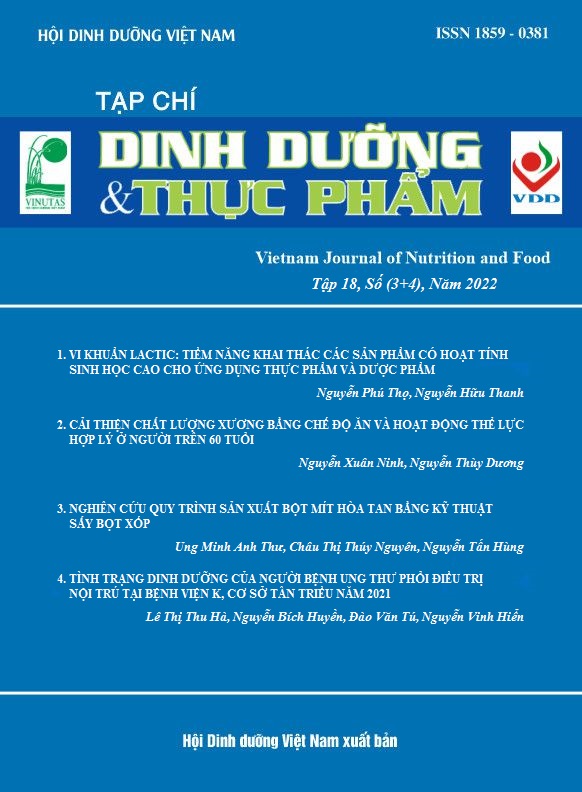CẢI THIỆN CHẤT LƯỢNG XƯƠNG BẰNG CHẾ ĐỘ ĂN VÀ HOẠT ĐỘNG THỂ LỰC HỢP LÝ Ở NGƯỜI TRÊN 60 TUỔI
Nội dung chính của bài viết
Tóm tắt
Mục tiêu: Đánh giá thiệu quả cải thiện mật độ xương (MMD), chất lượng xương (BQI), mức cản siêu âm (BUA), bằng chế độ ăn và tập thể lực hợp lý ở người >60 tuổi.
Phương pháp: Khẩu phần ăn trung bình /ngày 2000Kcal, 1200mg Ca, 1,7g protein /kg cân nặng, 800IU vitamin D3. Tập thể dục 3 buổi/tuần x 60 phút/buổi với kháng trở mức độ vừa và nặng, 45 phút dưỡng sinh vào mỗi buổi sáng, 8h làm việc tại văn phòng. Đo mật độ xương (bone mineral density, BMD) gót chân bằng máy siêu âm định lượng (quantitative ultrasound, QUS) 6 tháng/lần.
Kết quả: Bắt đầu can thiệp đối tượng có T-score xương -2,4 (đạt 64,5%, nguy cơ loãng xương), sau 48 tháng thực hiện, T-score xương là 0,8 (113,9%, mức tốt); các chỉ số khác như chất lượng xương (BQI), BUA cũng tăng từ 69,1 điểm, 39,5dB/MHz khi bắt đầu can thiệp lên 121,1điểm (tăng 95,6%) và 108,1dB/MHz sau 48 tháng.
Kết luận: Chế độ ăn và tập luyện hợp lý có tác dụng tốt phục hồi chất lượng xương ở người cao tuổi.
Từ khóa
Người cao tuổi, canxi, tập luyện, loãng xương, QUS, BQI, BUA
Chi tiết bài viết
Tài liệu tham khảo
2. WHO. Diagnosis and assessement. In: Prevention and management of osteoporosis. Geneva 2003. Pp 53-81.
3. Nguyễn Thị Ngọc Lan, Hoàng Hoa Sơn. Khảo sát yếu tố nguy cơ loãng xương ở phụ nữ Việt Nam từ 50 tuổi trở lên và nam giới từ 60 tuổi trở lên. Nghiên cứu Y học. 2015;5:91-98.
4. WHO. WHO guidelines on physical activity and sedentary behaviour: at a glance. Geneva 2020. Pp 4-6.
5. Dionyssiotis Y, Paspati I , Trovas G, et al. Association of physical exercise and calcium intake with bone mass measured by quantitative ultrasound. BMC Women’s Health. 2010, 10:12. doi:10.1186/1472-6874-10-12.
6. Bộ Y tế/Viện Dinh dưỡng. Nhu cầu dinh dưỡng khuyến nghị cho người Viêt Nam. NXB Y Học Hà Nội 2016.
7. Li C, Sun J, Yu L. Diagnostis value of calcaneal quantitative ultrsound in the evaluation of osteoporosis in milddle-aged and elderly patients. Medicine. 2022;101:1-6.
8. Zhu ZQ, Liu W, Xu CL, et al. Ultrasound bone densitometry of the calcaneus in healthy Chinese children and adolescents. Osteoporos Int. 2007;18:533–541.
9. Prins SH, et al. The role of quantitative ultrasound in the assessement of bone: a review. Clinical Physiology. 18;1:3-17.
10. Langton CM, Njeh CF, Hodgskinson R. Et al. (1996) Prediction of mechanical properties of the human calcaneus by broadband ultrasonic attenuation. Bone. 1996;18: 495±503.
11. Srichan W et al. Bone status measured by quantitative ultrasound: a comparison with DEXA in Thai children. Eur J Clin Nutr. 2015, 1–4. doi:10.1038/ejcn.2015.180
12. Albanese CV, De Terlizzi F, Passariello R. Quantitative ultrasound of the phalanges and DXA of the lumbar spine and proximal femur in evaluating the risk of osteoporotic vertebral fracture in postmenopausal women. Radiol Med. 2011;116:92–101.
13. Gluer CC. Quantitative ultrasound techniques for the assessment of osteoporosis: Expert agreement on current status. J Bone Miner Res. 1997;12:1280-1288.
14. Baran DT. Quantitative ultrasound: a technique to target women with low bone mass for preventive therapy. Am J Med. 1995; 98(2A):48S-51S.
15. Bennell KL, Hart P, Nattrass C, Wark JD. Acute and subacute changes in the ultrasound measurements of the calcaneus following intense exercise. Calcif Tissue Int. 1998;63:505-509.
16. Pinheiro MB , Oliveira J, Bauman A et al. Evidence on physical activity and osteoporosis prevention for people aged 65+ years: a systematic review to inform the WHO guidelines on physical activity and sedentary behaviour. Inter J Behav Nutr Phys Act. 2020;17:150-159.
17. Prince R, Devine A, Dick I, et al: The effects of calcium supplementation (milk powder or tablets) and exercise on bone density in postmenopausal women. J Bone Miner Res. 1995;10:1068-1075.
18. Nelson ME, Fisher EC, Dilmanian FA, et al. A 1-y walking program and increased dietary calcium in postmenopausal women: Effects on bone. Am J Clin Nutr. 1991;53:1304-1311.
19. Nelson ME, et al.. Effects of high-intensity strength training on multiple risk factors for osteoporotic fractures. JAMA. 1994;272:1909-1914.
20. Jones PRM et al. Influence of brisk walking on the broadband ultrasonic attenuation of the calcaneus in previously sedentary women aged 30-61 years. Calcif Tissue Int. 1991;49:112-115.
21. Hoshino H, Kushida K, Yamazaki K, et al. Effect of physical activity as a caddie on ultrasound measurements of the os calcis: a cross-sectionalcomparison. J Bone Miner Res. 1996;11:412-418.
22. Heinonen A, Kannus P, Sievanen H, et al. Randomised controlled trial of effect of high-impact exercise on selected risk factors for osteoporotic fractures. Lancet. 1996;348:1343-1347.
Các bài báo tương tự
- Phạm Quỳnh Anh, Ngô Thị Nhu, Phạm Thị Kiều Chinh, Phan Hướng Dương, HOẠT ĐỘNG CHĂM SÓC DINH DƯỠNG NGƯỜI BỆNH PHẪU THUẬT U XƠ TỬ CUNG ĐIỀU TRỊ TẠI BỆNH VIỆN PHỤ SẢN TỈNH THÁI BÌNH NĂM 2019 , Tạp chí Dinh dưỡng và Thực phẩm: Tập 16 Số 3+4 (2020)
Ông/Bà cũng có thể bắt đầu một tìm kiếm tương tự nâng cao cho bài báo này.


